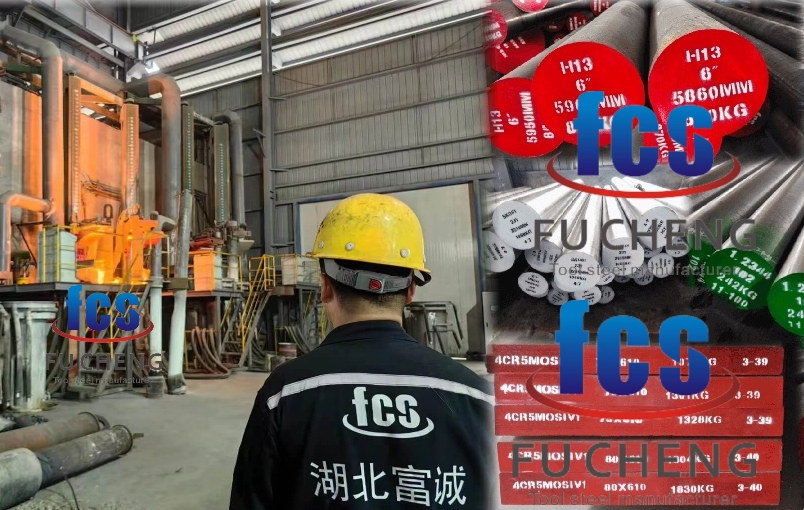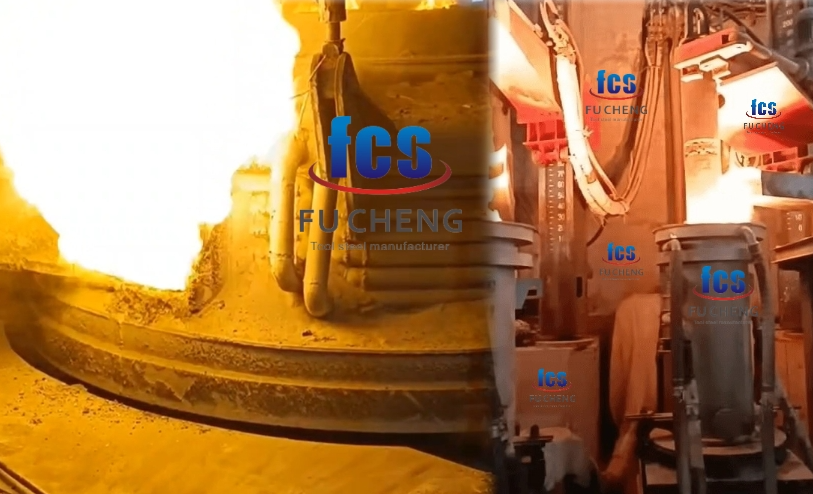From my perspective, deciding between H13 EAF steel and ESR steel can be tough. It’s like weighing a good value option against a premium one for your tools. Both tool steel types have their uses. But I suggest the choice becomes very important when tool life and the quality of your parts are at stake. I’ve noticed people often wonder if the added expense for ESR makes sense. Or, they question if standard H13 is good enough for the job. In my experience, most miss one crucial detail before making this decision…
Production Methods: EAF (Electric Arc Furnace) Process for H13 Steel

The Electric Arc Furnace (EAF) is a primary melting method used in H13 steel production.This method is energy-efficient and flexible, allowing for precise control of alloying elementsThe EAF method is the primary production process for H13 steel. It involves melting scrap steel and alloys using electric arcs, followed by refining steps like Ladle Furnace (LF) and Vacuum Degassing (VD) to adjust composition and reduce impurities. EAF is cost-effective and suitable for large-scale production but retains moderate inclusion levels (0.5–1.5% oxides/sulfides) and coarser grain structures.
Key Steps in EAF Production
1.Melting: Scrap steel, ferroalloys (e.g., chromium, molybdenum), and other raw materials are melted in the EAF at temperatures exceeding 1,600°C.
2.Refining: After melting, the molten steel undergoes secondary refining processes:
2.1. LF (Ladle Furnace): Adjusts composition, removes sulfur, and homogenizes temperature.
2.2. VD (Vacuum Degassing): Reduces hydrogen, nitrogen, and oxygen content to improve purity.
3.Casting: The refined steel is cast into ingots or billets.
Advantages of EAF
1.Cost-effective for large-scale production.
2.Suitable for recycling scrap materials.
3.Produces H13 steel with acceptable mechanical properties for general applications.
Limitations of EAF
Higher inclusion content compared to ESR due to residual oxides and impurities
Production Methods:Electroslag Remelted (ESR H13)

ESR is a secondary refining process applied to EAF-produced H13. The steel is remelted through a conductive slag layer, which absorbs impurities (e.g., oxides, sulfides) and reduces gas content (O, N, H). This results in ultra-low inclusions (<0.2%) and a homogeneous microstructure with fine grains. ESR enhances mechanical properties but adds 30–50% to production costsIt is often applied after EAF production to meet stringent quality requirements for critical applications like large-scale aluminum extrusion molds. In my opinion, the ESR process is a big improvement in quality over the standard EAF way of making steel. I find it especially useful for high-quality tools where if a tool breaks, it leads to high costs.
Key Steps in ESR Production
1.Electrode Preparation: The initial EAF-produced H13 tool steel is forged into a consumable electrode.
2.Remelting: The electrode is melted in a water-cooled copper mold filled with a flux (slag). Electrical resistance heating generates heat, melting the electrode tip.
3.Solidification: Molten metal droplets pass through the slag layer, where impurities are absorbed. The purified metal solidifies into a refined ingot with a uniform microstructure.
Advantages of ESR
1.Superior Purity: Removes non-metallic inclusions (e.g., oxides, sulfides) and reduces gas content (O, N, H).
2.Improved Microstructure: Eliminates macrosegregation, resulting in fine, homogeneous grains.
3.Enhanced Mechanical Properties: Higher impact toughness and fatigue resistance, critical for large molds (>600 mm) subjected to extreme thermal stresses.
Limitations
Higher production costs due to additional processing steps.
Comparative Analysis: EAF H13 vs. ESR H13 Tool Steel

I’ve seen H13 tool steel used often in die casting, forging, and other jobs involving high temperatures. The way this steel is made really affects how it performs. Electric Furnace H13 and ESR (Electro-Slag Remelting) H13 are two quality levels of the same material, and I find the manufacturing difference is key.
Deciding between Electric Furnace H13 and ESR H13 is, in my opinion, a typical choice between quality and cost. For everyday uses, standard H13 works well enough and costs less. For tough jobs where a tool breaking would be very expensive, or if you need an excellent surface finish, I believe paying extra for ESR H13 usually pays off. You generally get longer tool life and better results, which I have seen lead to a good return on the initial investment.
Key Differences: EAF vs. ESR H13 Steel
| Aspect | EAF H13 | ESR H13 |
|---|---|---|
| Process Type | Primary melting | Secondary refining |
| Inclusions | Moderate (trapped oxides/sulfides) | Ultra-low (slag absorbs impurities) |
| Microstructure | Coarser grains, minor segregation | Fine, uniform grains |
| Mechanical Properties | Good strength, moderate toughness | Superior toughness, fatigue resistance |
| Cost | Lower | Significantly higher |
| Typical Use Cases | General tooling, small dies | High-performance molds, aerospace parts |
My Guide to Choosing H13 Tool Steel

Electric Furnace H13: The Practical Choice
Electric Arc Furnace (EAF) H13 is typically selected when there is a need for flexible, efficient steel production using scrap metal or direct reduced iron (DRI) as raw materials. It is suitable for processes requiring high temperatures (up to about 3,500°C) to melt and refine steel rapidly through electric arcs formed between electrodes and the scrap. EAF H13 is chosen in scenarios where environmental concerns are important, as some designs avoid scrap preheating to reduce emissions like dioxins, VOCs, and NOx, while maintaining productivity and safety. It is also preferred when power quality and energy consumption need to be managed carefully, since EAFs can cause voltage flicker and harmonics, and their operation involves fluctuating current and reactive power. The furnace is ideal for steelworks requiring tap weights typically from 20 to 300 tons, with automation and electrode control systems that optimize energy use and electrode consumption. Overall, EAF H13 is selected for modern, green steel production that demands flexibility in raw material feeding, energy efficiency, and environmental compliance.
ESR (Electro-Slag Remelted) H13: The High-Performance Solution
ESR H13 steps in when failure isn’t an option. This premium grade is engineered for mission-critical applications where safety, longevity, and precision are non-negotiable. Its refined material structure—achieved through electroslag remelting—minimizes micro-inclusions and internal flaws, making it indispensable for tools subjected to extreme thermal cycling (e.g., aluminum extrusion molds operating above 500°C) or heavy mechanical stress (e.g., aerospace components). The exceptional fatigue resistance ensures prolonged tool life, while the ultra-smooth surface quality allows for flawless mirror polishing, essential for high-end consumer products or optical-grade finishes. Though the upfront cost is 20–40% higher than Electric Furnace H13, ESR pays for itself in high-stakes environments. Reduced tool replacements, fewer production halts, and superior part quality translate to long-term savings, particularly in industries like automotive or medical manufacturing where defects are costly.
Economic Analysis: Balancing Cost and Value
The price premium of ESR H13 often sparks debate, but its economic justification becomes clear when evaluating lifecycle costs. For example, in large-scale aluminum extrusion—where a single mold failure can halt production for days—the extended lifespan of ESR-processed tools directly offsets downtime expenses. Fewer rejected parts and tighter dimensional tolerances also reduce material waste, enhancing overall process efficiency. In contrast, Electric Furnace H13 remains the economical backbone for small-to-medium enterprises or applications where tools face predictable wear. Its lower initial investment suits prototypes, low-volume production, or scenarios where frequent tool redesigns negate the need for ultra-durability.
Ultimately, the choice hinges on operational priorities:
1.Short-term cost control: Electric Furnace H13.
2.Long-term value and risk mitigation: ESR H13.
For industries like automotive or aerospace, hybrid strategies—using ESR for critical tool components and Electric Furnace for non-structural parts—offer a balanced approach. Always align your selection with the tool’s role in your workflow, regulatory requirements, and total cost of ownership.
Expert Opinion:
“I’m a metallurgical engineer. I have over 20 years of experience with tool steel. Based on my experience, choosing between EAF and ESR H13 is about managing risk. The performance difference in real-world use is clearest in high-stress jobs. This is particularly true with extreme thermal cycling. In my work with major automotive die manufacturers, my observations show ESR H13 tools last 30-40% longer. These tools also have far fewer failures. I know the initial investment for ESR H13 is higher. However, when I calculate the ROI, I always include more than just replacement costs. It’s important to also consider the large hidden expenses from production downtime. In large operations, this downtime can easily cost $10,000 or more per hour. For critical components, failure is not an option. From my perspective, ESR H13 is more than a premium choice in these situations. I recommend it as often the most economical decision over the tool’s complete lifespan.”
———— Dr. Michael Reynolds , Chief Metallurgist at Advanced Tool Materials Institute and former Technical Director at International Steel Foundry Association
summary
Based on my experience with both steel types, I’ve learned that choosing the right one depends on what you need it for. I’ve found EAF H13 works well and is cost-effective for many standard jobs. For parts that absolutely must not fail, I recommend ESR H13; it offers top quality and lasts much longer. I suggest you think about what your project needs. Also, consider how much you will produce and the long-term costs before you decide. From my perspective, paying more at the start can often save a good amount of money in the long run. No matter which steel you pick, I believe understanding these points helps you choose tooling. This way, your choice will better match your manufacturing targets and what you can afford.
